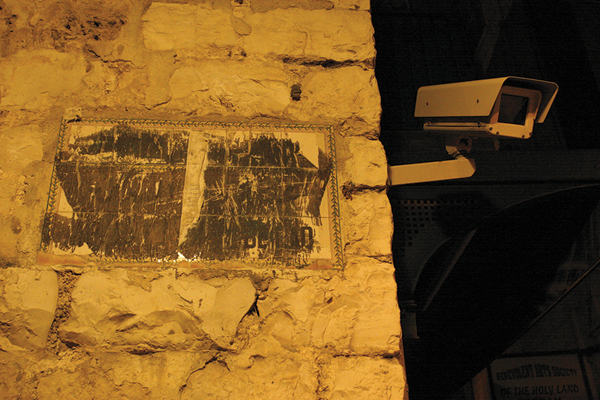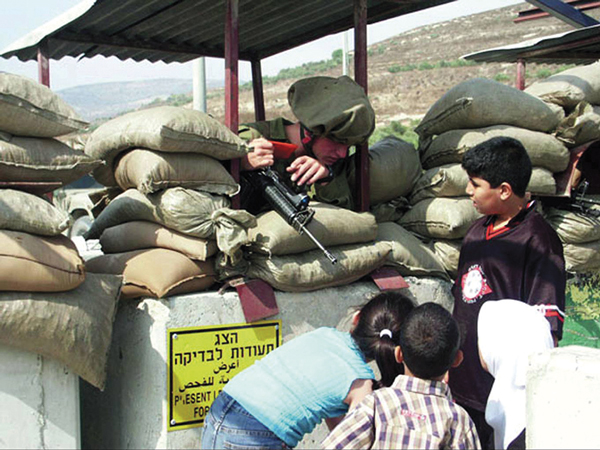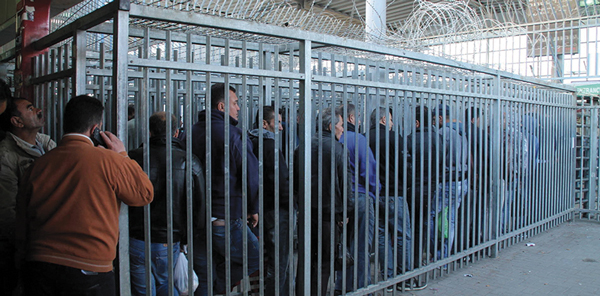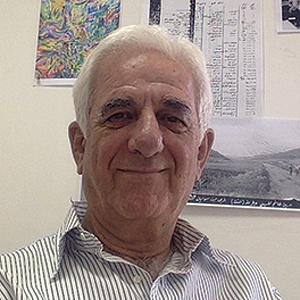
Jerusalem Quarterly, in two recent issues, has examined the intelligence and security regimes that have monitored Jerusalem and Palestinian lives over the last century.* In articles that illuminate practices undertaken since the Ottoman Empire and World War I, contributors (including Elia Zureik, Johnny Mansour, Nadera Shalhoub-Kevorkian, Ahmad H. Sa’di, and many more) reflected on the continued and various efforts that have collected and recorded information for the sake of political control and disruption, recounting its developments and innovations.
These issues explore surveillance, beginning with the history of spying in Palestine (with fascinating detail that goes beyond the scope of this issue’s theme) by illustrating how the Zionist movement from the beginning strove to develop lasting intelligence infrastructures that extend into the present time. For example, in so-called Village Files (Saleh Abdul Jawwad) the pre-state security apparatus of the Haganah monitored and recorded the daily life of Palestinians in the 1930s and 1940s. The case of the village of Al-Bireh is both frightening and fascinating: the report highlights the most intimate details of local village lives. Details range from consumption patterns, featuring, for example, the itemization of the Birawi family’s entire belongings (including chickens and chicken coops, radios, and other “modern” items) to cropping arrangements, household furniture, marriage patterns, land title deeds, and elite formations. The variety of sources raises the issue of collaboration between the Zionist leadership and local as well as foreign scholars and visiting archeologists. These Village Files not only attracted Zionist attention prior to the conquest of 1948 and the occupation of 1967, but also provided important insights for the new state of Israel and its policies in the aftermath of these momentous events.
“Stifling Surveillance” examines efforts of the Israeli military government following the Nakba to “de-nationalize” the Arab community by undermining extended forms of solidarity with the forcibly exiled Palestinian community. With such mechanisms, Israel explicitly strove to incorporate the residual Palestinian population “at the margins of the Israeli polity and economy as subordinate collectivities devoid of an overarching identity, vision, will, or ability to resist.” The same objectives continue to determine policies today, albeit in a different format.
♦ The pervasiveness of surveillance in the Israeli matrix of control over the daily lives of Palestinians extends to body searches, identity documentation, and standing in line for hours while awaiting a signal from Israeli soldiers to either proceed or be turned away (emblematic of the checkpoint experience), and is characterized by dehumanization, lack of sovereignty, and overall limitation on free movement.
Moving on to the present, the sociology of contemporary surveillance in Jerusalem and the occupied territories is examined, and focus is placed on the punitive revocation of Jerusalem residency for Palestinians. In particular, the introduction of a new basis for punitive revocation – “breach of allegiance to the state of Israel” – indicates the ever-increasing discipline that Israeli rule demands.

Population registration – including the census or the permit regimes that govern the movement of people which Israel introduced in the pre- and post-1967 periods in the name of state security – was crafted in such a way as to further spatial control and the expansion of Jewish colonies, restrict mobility, and stunt economic development of the Arab sector with walls and fences, checkpoints, watchtowers, and segregation barriers in the background, not to mention the panoply of high-technology surveillance machinery. Israel’s seemingly constant development of technologies of surveillance and suppression is addressed in Daoud Talhami’s review of Jeff Halper’s War against the People that applauds Halper’s clear-sighted evaluation of Israel’s security-industrial complex, its links to Israel’s foreign policy, and the international impunity that it has managed to secure through the sale of weapons and security technology to states and regimes worldwide. Furthermore, by claiming that its military technologies have been tested in the laboratory of the occupied territories, Israel has managed to turn its failure to pacify the Palestinian population into a marketing strategy. Israel’s security “products” include not only conventional weapons but also satellite technology and drones, and “the militarization and weaponization of research in scientific fields, including genetics, nanotechnology, and biotechnology.”

A report by 7amleh – Arab Center for Social Media Advancement – indicates the degree to which Israeli (and Palestinian) security services have infiltrated social media, rendering its Palestinian users vulnerable to harassment and arrest. Helga Tawil-Souri, in “Surveillance Sublime,” notes that even the latest and most advanced technologies of surveillance merely supplement, rather than supplant, the tried and true “low-tech” methods developed well before 1948. Technologies that were fundamental to early colonial and state control, such as population registries, identification cards, land surveys, and mapping, remain a central part of Israel’s surveillance regime. And much surveillance still relies on old fashioned intelligence and data gathering on the ground: a police force, intelligence agents, informants, spies, infiltrators, collaborators, imprisonment, torture and interrogation methods, observation from a distance and direct observation, differentiated infrastructure, territorial mapping, land surveys and registration, urban planning, architecture, watchtowers, population registration, censuses, identification papers, and slightly newer low-tech tools such as postal interception, wiretapping, and x-ray machines. While an increasing number of tools – such as drones, remote-controlled robots, biometric data collection, and computer viruses – are hi-tech, they do not displace low-tech ones but supplement them. With some irony, Tawil-Souri reflects on the state’s attempt to usurp the all-seeing power (though not the all-loving potential) of God in the holy city of Jerusalem. Indeed, it is only in modern history that omniscient surveillance became a secular rather than a divine imperative. Anne Meneley documents a form of self-surveillance in a wry review of A Slim Peace, a 2007 documentary about seven Palestinian and seven Israeli women who join a common weight-loss group in the settlement of Gush Etzion. Meneley suggests that this joint self-surveillance can provide grounds for the development of shared political subjectivity .The film records a bizarre and questionable example of a “normalization discourse” that assumes that nongovernmental practices and interactions can somehow lead to an end of violence or acceptance of the very unequal state of affairs in the Holy Land.
» Salim Tamari is a senior fellow at the Institute for Palestine Studies (IPS) and the former director of the IPS-affiliated Institute of Jerusalem Studies. He is editor of Jerusalem Quarterly. A professor of sociology at Birzeit University and an adjunct professor at the Center for Contemporary Arab Studies at Georgetown University, Dr. Tamari has authored several works on urban culture, political sociology, biography and social history, and the social history of the Eastern Mediterranean.
* This article summarizes contributions related to surveillance in the two issues of Jerusalem Quarterly, themed “We are watching you” and “We are Still Watching You: Counting Cameras, Chicken Coops, and Calories of Power,” published by The Institute of Jerusalem Studies.


